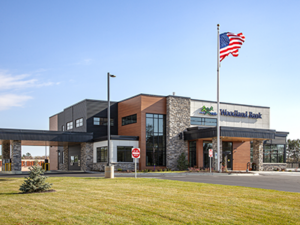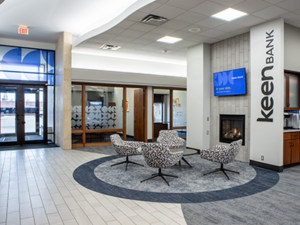“The time was right.”
Brian Nicklason, CEO of Grand Rapids, Minn.-based Woodland Bank, knew that his growing bank needed more space. The $132 million bank had been operating for several years in a 5,000-square-foot building once occupied by a hotel and had always planned to move into a larger facility.

Even as banks shuttered their physical branches during the pandemic, Nicklason remained committed to demolishing the older facility to build a 13,000-square-foot building on the same site. The bank methodically researched how other financial institutions planned to use their spaces in the coming years. Woodland leadership realized through the process that the best chance for success was not only establishing a bank but also dedicating itself to become a community gathering space.
The bank moved into the three-story building last October following a year-long construction process. Woodland wanted the building’s layout to reflect broader changes in branch offerings. The facility’s lower level includes an employee lounge. Woodland Bank replaced the traditionally separated teller lines with teller pods on the main floor and built a large fireplace. The building has tall ceilings and ample natural lighting.
The building includes a deck that can host cocktail receptions and employee lunches. As a community business center, the building comes complete with an attorney’s office and coffee bar. Customers, nonprofits and other community groups can reserve meeting space for free.
“It’s a cozy, comfortable space in a nice casual setting,” Nicklason added. “When they walk in it doesn’t feel like a traditional bank. It’s a very comfortable feeling. It’s not stuffy. It’s open.”
“It’s helping the community by giving them a one-stop shop,” added Adam Holmes, CEO of Minneapolis-based Vanman Architects, the lead designer of the project. “They’ve got the ability to come and do their banking, their insurance, maybe their legal work, so [the bank focused on] bringing professionals into that space to create that business center for the community.”
Woodland Bank’s new building exemplifies the future of the bank branch as an aesthetically welcoming, personalized gathering space for both bank customers and the broader community.
Another example of this trend is Waseca, Minn.-based Keen Bank. The bank recently upgraded its interior colors from warmer colors popular 15 to 20 years ago to lighter hues, including gray, white and blue. The $175 million bank also built a new lobby. A marble wall behind the teller line once covered in wallpaper is now the lobby’s centerpiece. Leather seating that was challenging for older customers to navigate was replaced with easier-to-use furnishings.

“It’s the reception that they get when they come into the bank,” said President and CEO Bernie Gaytko. “It’s knowing who their bankers are when they walk in and having a recognizable, friendly face there waiting for them. That’s what makes Keen Bank, and I think all of the other things that are done — the buildings, the branches, the names — those are ancillary. They will either complement or distract from it, and I think in our case it complemented what we were trying to do.”
The bank, which had a drive-up space only 30 feet from the building, rerouted pneumatic tubes inside of the building, allowing tellers to service the drive-thru while being inside of the main building. The rerouting cut the number of tellers the bank needed to three from five, coinciding with the retirement of two cashiers. Now, much of the traffic that used to come through the drive-up visits the lobby instead. “It’s been a great way to reintroduce ourselves to our customers, especially now that we’ve remodeled the interior and rebranded,” Gaytko added.
Amid the renovations, First National Bank of Waseca rebranded to Keen Bank last September, distinguishing itself from the myriad other banks with a similar name and better reflecting its multi-city presence. “We weren’t bought or sold or acquired or anything like that; we were just building upon our legacy,” said Marketing Officer Briana Worke. “To be able to freshen the space and make everything look new but still have those pieces and that familiarity, I think is important.”
In 2014, the $539 million HomeTown Bank synthesized a full-service cafe into the lobby of a 12,000-square-foot building in which the bank had a branch. HTG Architects, Hopkins, Minn., designed a drive-up window for the coffee shop on the east side of the building. The main entrance for the building is on the north side of Highway 5, the main thoroughfare in Waconia, Minn.

As customers enter, they see the lobby’s fireplace and lounge. The area occupies the center of the lobby which the bank and coffee shop share. The bank space wraps around to the left, while the cafe space wraps around to the right. There is no wall separating the two operations. HTG designed the lobby so that a customer can stand in the cafe and see HomeTown staff in the same space with them. A CPA and a title agency rent space from the bank. Because of the coffee shop, professionals such as recruiters, realtors and financial planners who enter the lobby regularly meet with customers over coffee.
HTG President Sean Raboin said the coffee shop has driven business into the branch. His firm is working with the Redwood Falls, Minn.-based HomeTown Bank on a couple other projects with the same coffee-shop model. “It’s been a huge success story for them,” he added.
Preparing for the future
As the overall number of bank branches continues to fall, bank executives must realize that economic considerations from five years ago no longer apply, Raboin said. Banks must position themselves in prime real estate locations to effectively jockey with vastly increased competition.
Woodland Bank is headquartered near major businesses, including Home Depot, Target and Walmart. “Don’t think about the next two to three years, think about the next 10 years,” Nicklason advised other banks considering building a new facility. “What is your bank going to look like? What is the community going to look like? Don’t be afraid to think about how your bank building can be used differently, maybe in ways that you can’t even imagine.”
In Montana, Helena-based Opportunity Bank has added several new facilities to its footprint and remodeled existing buildings over the last several years, said Kory Kennaugh, principal architect at Helena’s CWG Architects, which worked with Opportunity Bank on the project. The bank has also upgraded administrative facilities for back-of-house functions, and has switched to teller pods instead of using teller lines. The bank is staying away from remote tellers as it still wants customers to physically interact with front-line staff.
The rapid onset of online banking is driving down the overall number of branches as banks reduce costs. The number of net branches fell 3.6 percent in 2021 to 72,405 from 75,172 in 2020, and has fallen 15.3 percent from 85,512 in 2011, according to the FDIC.
Branch visits among mobile bank app users remained below pre-pandemic levels. Only 40 percent of respondents to S&P Global Market Intelligence’s 2022 mobile banking survey had visited a branch in the last 30 days. While that was a slight increase from the previous year, it was still down from the 47 percent of respondents who said the same in 2019.
Banks are moving away from large buildings to more limited square footage as they find efficiencies allowing a single person to perform multiple tasks, Holmes noted. “It’s been a shift that’s been happening, but I think the pandemic sped things up in that respect, because banks saw foot traffic drop to zero during the pandemic,” he said. “Now they’re taking a look and seeing more online banking opportunities, more opportunities to have that client connection and relationship that may not be face-to-face in the bank.”
Though banks need fewer branches and fewer employees to staff them, there’s still value in having a physical presence. According to a Sykes survey of 1,800 adults on their banking habits during the pandemic, 55 percent said they had visited a bank branch in-person within the last year, a majority of whom went to deposit money into an account.
According to BAI Banking Strategies, bank leaders should design their branches with a local touch. To do so, the firm suggested undertaking grassroots research, conducting walk-throughs from the perspective of a customer or associate; assessing how many branches are needed; and identifying significant parts of the local culture, including sports teams, national parks or community landmarks.
“Most consumers are no longer coming in for quick tasks that can be achieved online,” said Craig Thompson, senior vice president of client services at Atlanta-based design firm Miller Zell. “Instead, they’re seeking banker interaction for higher value conversations.”
